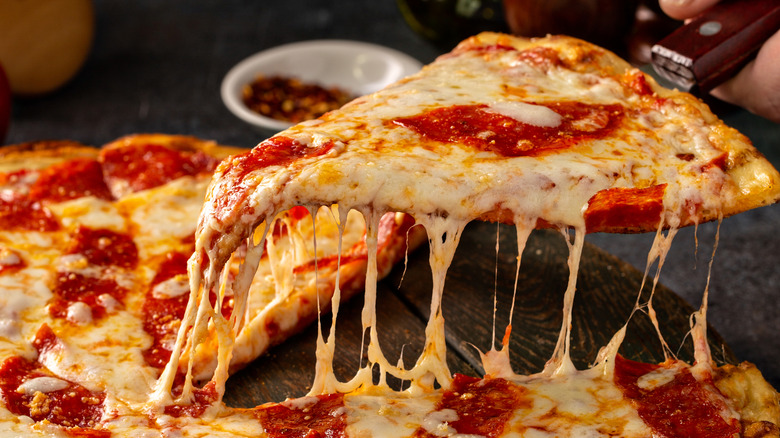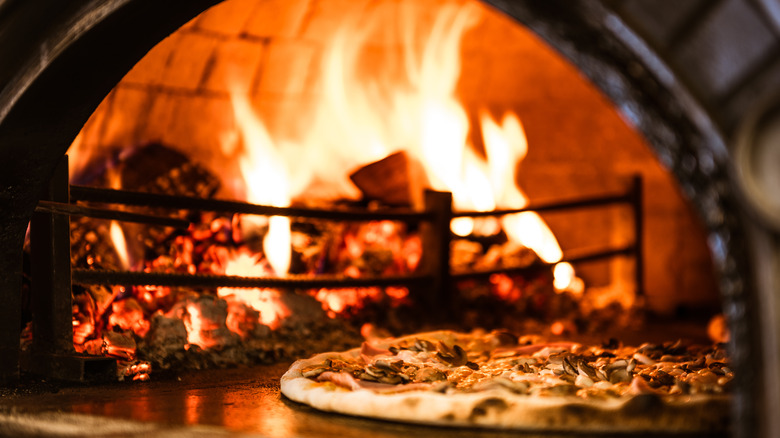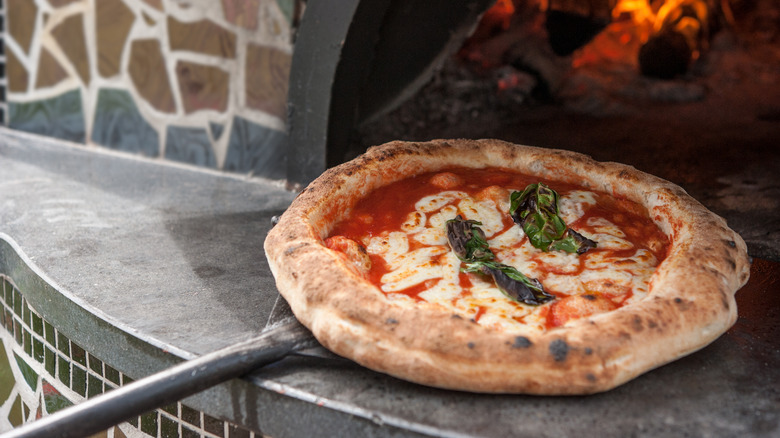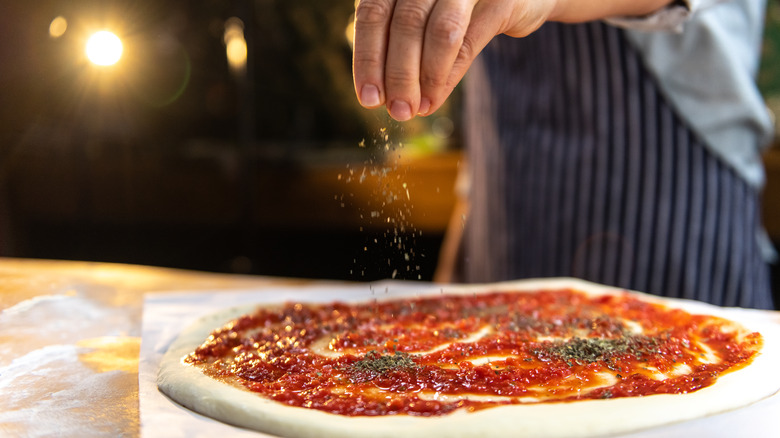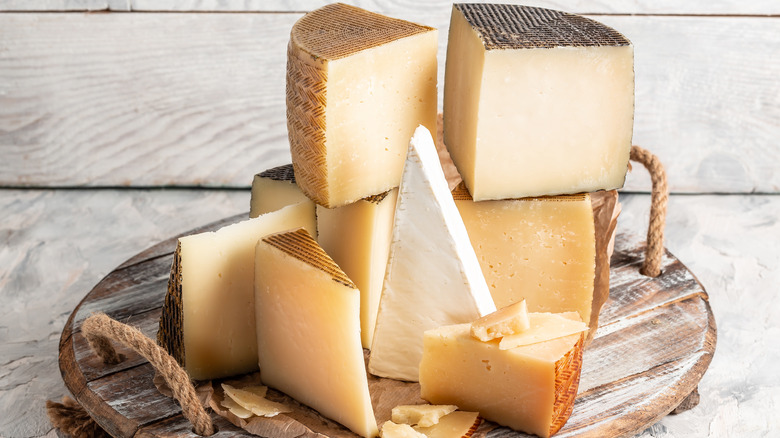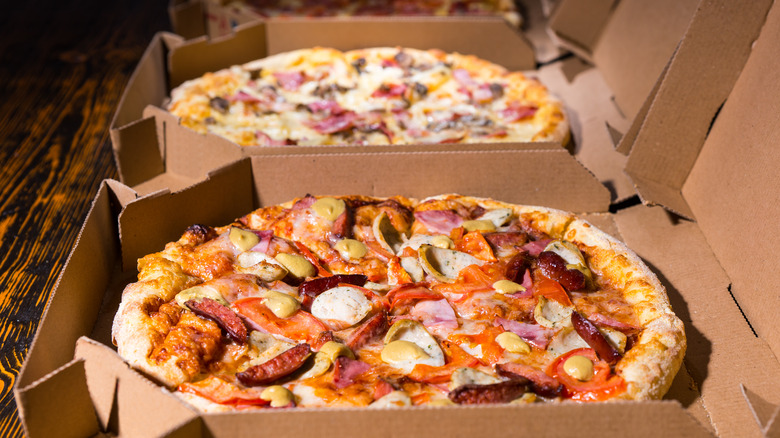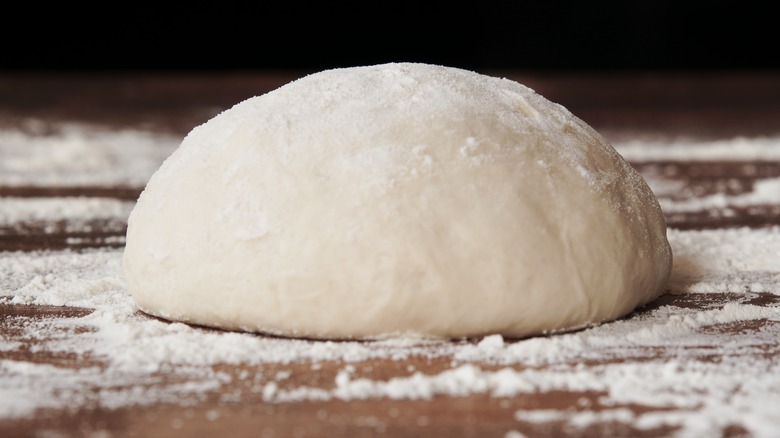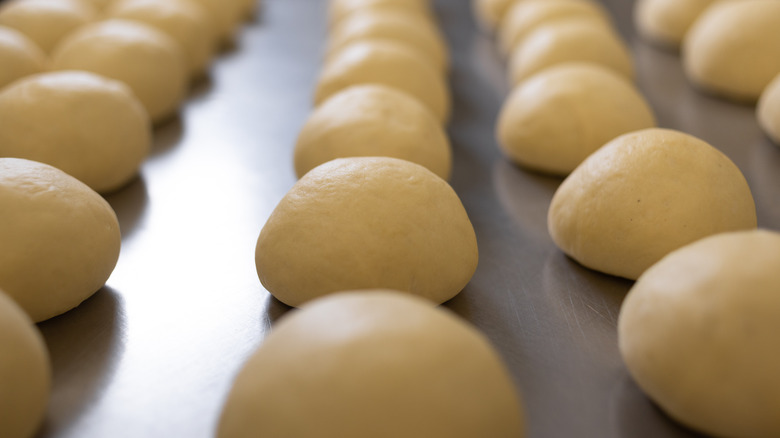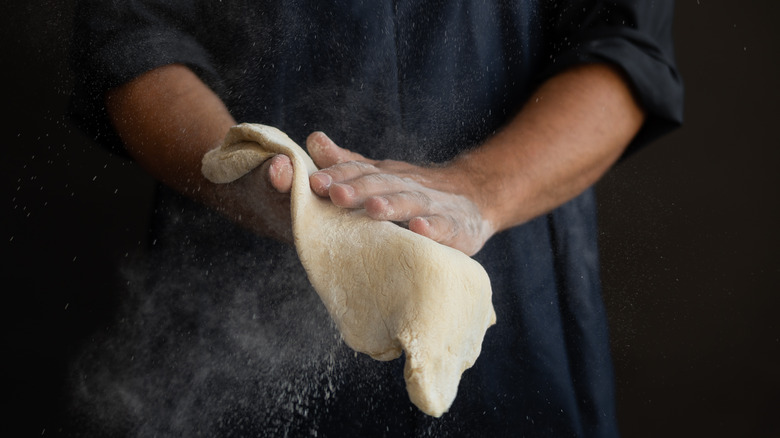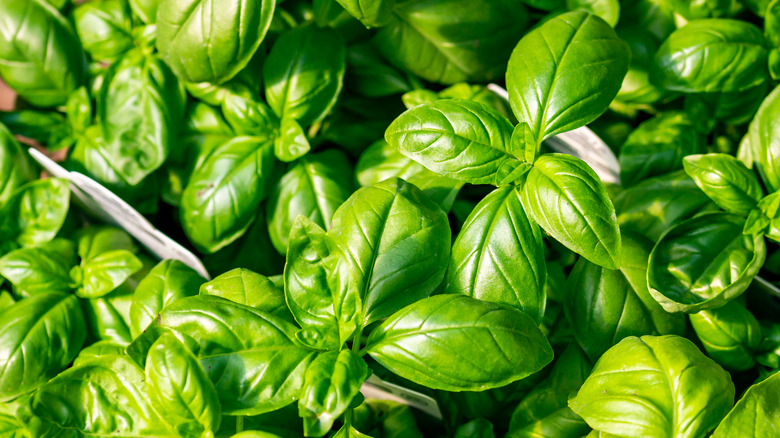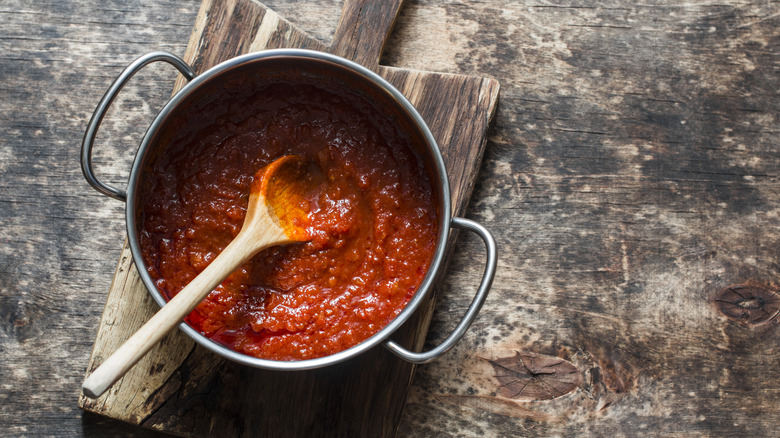Why Pizza Always Tastes Better At A Restaurant
We've all been there: It's your fourth time at your local pizzeria this week, you've grabbed your favorite slice, and you've left the shop with a spending habit you aren't too proud of. The guilt creeps in, and you're left thinking how much cheaper it would be if only you made your own pizza at home. But hey, rest assured this would be a difficult task for those not well versed in what it takes to recreate a restaurant-quality pie from scratch.
Let this be justification that, unless you run a fully functioning pizzeria in your own kitchen, you aren't going to get that flawless, godly slice you're craving day in and day out. The slightly crispy, yet soft crust with the ideal balance of tomato sauce, stretchy cheese, and spice blends all have precise methods behind their perfection.
From using specific ingredients to produce a fresh tomato sauce, adjusting flour and water ratios to pull off the perfect dough, and having the equipment necessary to make your tomato pie dreams come true, it's no wonder pizzas from the outside world offer a more satisfying experience than something you've baked at home. Sure, there are ways to turn your pizza-making game up a notch or two, but plainly said, most home cooks won't have access to what makes a restaurant-quality pizza what it is. Here are some reasons why pizza always tastes better at restaurants.
You can't truly recreate a pizzeria's oven at home
It's undeniable that a brick oven produces some of the smokiest, rustic and most mouthwatering smells known to mankind. According to Inside Science, using a wood-fired brick oven is what's best for pizza. Restaurants use these ovens because the key to a well-rounded savory tomato pie is for both the toppings and the dough on the bottom to finish cooking simultaneously.
For this to happen, the temperature must reach about 625 degrees Fahrenheit, something most conventional ovens simply cannot do. The hollow chamber that is a brick oven allows for high heat to bake the top of the pizza while its bricks take on thermodynamic qualities, ensuring a thorough, even heating from one end of the crust to the other. Inside Science tells us that by exposing your pizza to such high heat, it only takes about 2 minutes to cook, and that's thanks to the consistent amount of heat being produced by the small fire in this type of oven. The overall quality of a pizza improves when cooked in a brick oven, from crispier toppings to a perfectly charred crust. Good luck recreating that effect in a conventional oven!
Pizzerias use pizza peels
You may think that transferring your raw pizza to a baking sheet and popping the pan in an oven is enough to create a high-grade pizza. But that's far from the truth. First off, you'll need a pizza peel, which is a large, flat spatula with a long handle, to properly transfer your pie into the oven. Utilizing a wood or metal peel also helps pizza makers place their uncooked creation directly on a hot surface, with the help of flour dusted on metal peels to avoid any sticky dough residue, Mama Cucina informs us.
This tool also helps ensure even heating by allowing you to rotate the pie as it cooks — something that cannot be done as easily in a conventional oven due to lack of space. Home cooks could buy their own peel with a shorter handle, which would be better than omitting one altogether.
Some at-home chefs assemble a pizza directly on a peel so the fully loaded pizza can be shifted into an oven more carefully than without one (per Insider). A peel is an even more useful instrument for pulling the pizza out when it's done.
Pizza makers use a thin layer of tomato sauce
Ever see professional pizza makers ladle on a nice thin layer of red sauce on a soft, fluffy pizza dough and think it wasn't nearly enough to suffice? Hold your horses and think again. There's a reason this method works and makes for a well-balanced bite of tomato pie.
Too much sauce adds unnecessary weight to a pizza, and dough won't do well under its pressure. No pizza lover desires a soggy crust, and stellar pizza makers know how to keep this from happening. According to Pizza Planet, sauce should be spread so that there's just enough to mask the dough, making sure it doesn't outshine its toppings. The sauce will also cook simultaneously with the dough, so having a thinner layer will heat it through more effectively.
It's worth mentioning that at home, your instincts might tell you to go ahead and use up that leftover pasta sauce for the pizza dinner you plan on making. While you might be tempted to use the two interchangeably, Webstaurant Store tells us they're different enough and should only be used for their respective purposes. Why? Pizza sauce is typically a little thicker in consistency than pasta sauce, hence the reason a thin layer does the trick for pizza, whereas with a thinner pasta sauce, you might desire a larger portion to fully coat your rigatoni.
Restaurants often use cheese blends
When it comes to cheese, one trick pizzerias do that you might be missing out on at home is pairing the right kinds together. According to Insider, topping a pizza with the appropriate cheese blend offers advantages over letting just one cheese perform solo.
David Kay, a former restaurant cook who started operating a pizza business out of his home in New York City in 2020, told Insider he uses a blend of cheeses low on moisture. Topping a pizza with too much wet cheese will make for a damp pie, and who wants that? Contrary to what you might think, Kay also points out that using fresh cheese often creates excess liquid. The secret? Kay uses low-moisture mozzarella along with a small batch of fresh mozzarella mixed with a couple of hard cheeses he gets shipped in from Wisconsin.
Certain cheeses provide a pie with more gooey meltiness, which is why mozzarella and provolone are often coupled together, per Webstaurant Store. Another option used in restaurants is Gruyère, and though it's a hard cheese, it contains a great melting ability. Varieties like Parmesan and cheddar do not endure heat well and have a lower amount of elasticity. You might experiment with different cheeses to come up with your favorite blend because ... why not?
The toppings don't drown the pizza in moisture due to careful cooking methods
Soggy toppings on a pizza can be one reason to skip the homemade attempt altogether and walk down to your nearest pizza parlor for a better pie. The problem? When prepping pizza toppings at home, it's easy to forget that vegetables hold in moisture and will release water while your pizza is baking. This can cause potential crispiness in your crust to get lost completely.
Sautéing vegetables first so they shrink allows for their moisture to evaporate before you put them on your pizza, per Crust Kingdom. Cooking root vegetables like carrots and onions first is essential before putting them atop your pizza, as their natural sweetness comes through as they are heated, in turn leaving behind the taste of raw vegetable, according to Crust Kingdom. Draining your vegetables and patting them dry is also helpful. Using ingredients with more of an oily consistency can help avoid this issue as well.
Because pizzerias are able to use higher oven temperatures, their toppings cook efficiently rather than too slowly, which allows for moisture release. When it comes to meat, some pizzerias pre-cook toppings like sausage for food safety, pizzeria owners shared via PMQ Pizza Magazine. Heavy toppings may also create a wet layer between them and the dough, causing bare, no-sauce patches. And that isn't what you'd want either.
Restaurants use flour with a high gluten content
If it's all in the dough, pizza crust must start with great flour. How do so many expert pizza chefs achieve that delicate, perfectly balanced dough to create a heavenly crust? Well, it takes a bit more elbow grease than simply purchasing your favorite dough at the grocery store. Bleached flour doesn't compare with flour sourced from a mill, according to Food Republic. Shawn McClain, chef and managing partner at Five50 Pizza Bar, for example, said he uses only fresh-milled flour for his dough (via PMQ Pizza Magazine.)
Other pizza experts such as Craftworks Restaurants and Breweries senior director Mike Thom, whose company operates the Old Chicago Pizza & Taproom chain, agree that having a quality flour is key. To relate to health-conscious consumers, the chain uses flour made from wheat that's free of enzymes and additives, per PMQ Pizza Magazine. Flour containing less protein will carry less gluten, whereas more protein means added gluten, per Food Insight, and too much gluten will turn pizza dough into a dense ball of not-so-goodness. Thom said the chain uses a lower-protein flour for thin crust pizzas, while a higher protein flour is used for Chicago-style deep-dish pizzas and pizza-adjacent foods like calzones. Will Bingham, owner of The Pizza Peel and Taproom, said he combines high-gluten white flour with wheat flour to add volume to his dough, per PMQ Pizza Magazine. Unless you're a chemist, achieving this balance at home takes great patience.
Pizzerias use filtered water to improve dough texture
The conversation around what kind of water is most effective for pizza dough has been one of great contention. However, it's safe to assume that water with a higher quality will make for a better dough. According to Fortun's Kitchen, some pizza chefs believe using filtered water will improve the texture of pizza crust. Although not every chef agrees, many say that it's at least one step above using an unfiltered alternative.
The acidity, purity and hardness of water are all components that affect dough, according to Pizza University. The water's PH level, which determines how acidic it is, can either work for or against a pizza crust's elasticity and overall weight. In addition, water high in chlorine content runs the risk of affecting the cultures in pizza dough, per Pizza University. As a remedy for that, some pizzerias will leave water to sit out uncovered overnight so that the chlorine slowly releases itself. The amount of mineral content in the water must also be enough to help the yeast as part of its fermentation process, Pizza University explains. Some pizzerias opt to use bottled water in their pizza dough, though this can get expensive.
According to top pizza chefs via Fortun's Kitchen, another key to keep your dough from falling flat is to season it with salt. If you're wondering why it's so difficult making that perfect pizza dough at home, perhaps this is why.
Restaurants often proof homemade dough
If you're used to buying pizza dough, you may not realize what goes into a homemade batch. We want to let you in on a little secret about how some restaurants approach their dough, giving them the final crusty texture — and it lies in the proofing.
Take, for instance, executive chef Matteo Schiavone of Pomo Pizzeria Napoletana, who swears by double fermentation, in other words, letting the dough rise twice, according to PMQ Pizza Magazine. First, he lets his dough rise for 4 hours, then folds it into a ball, and lets it rise for another 8 to 12 hours. He adds that dough raised with too little time results in a heavier pizza. He cautions chefs to be aware that warmer temperatures increase the dough's ability to rise faster, so he stores batches in the cooler for the first proofing and at about 70 degrees during that second period to keep the texture soft.
The goal for a great pizzeria is not to create bread dough, but rather a light and airy crust. But over-kneading leads to more bready dough, as reported by Cucina Dolce. Cold temperatures makes pizza doughs more compact and tight, resulting in the gluten holding together more and complicating the kneading process. Cooking cold dough is helpful if you prefer a denser crust, though a restaurant succeeding in the pizza department will have its dough double proofed and unfrozen. Cucina Dolce recommends kneading for no more than 6 minutes.
Hand stretching the dough makes for a better crust
Ever seem like the hardest part of making pizza lies in the doughy bed its entire existences relies on? Hand tossing and properly stretching pizza dough should probably be left to the experts, and that's because it takes practice. The importance of stretching dough as opposed to, say, rolling it lies in the final product you'll be left with. Top-notch pizzerias in New York City, known for their tomato pie perfection, often structure their dough around texture so that components like air bubbles yield just the right balance, as reported by Food Republic. Another trick — the art of hand-tossing dough — contributes to a traditionally thinner crust, according to Fortun's Kitchen.
It can also be easier for pizza makers to work with dough by hand, we learn from PMQ Pizza Magazine. Take New York City, for example, where there are endless pizza options and types of crust to cater to every preference. By pushing air out of dough when stretching it, you can create a thinner New York City crust. Restaurant Five50 retains air in its dough with a pulling technique that results in a chewable texture rather than a denser product.
Using minimal but fresh herbs to bring out the tomato sauce
There you are, assembling your pizza sauce, and before you know it, you've overloaded it with spices you don't feel confident about. The choice of seasonings can truly make or break a pizza sauce. Ever experience the sensation of an acidic tomato sauce or worse — a flavorless one altogether? Whether you're attempting to do too much or aren't sure what goes in a pizza sauce, know that pizzerias typically keep things simple for results that are golden.
The goal of a good sauce is to highlight the pizza's flavors rather than upstage them, kindly complimenting already-existing notes in the tomatoes. Practicing restraint helps a sauce have just the right amount of seasoning, especially when salty, flavor-packed toppings are involved. Fresh-grown basil, oregano and garlic are flavors frequently used in pizzerias to do just that. Webstaurant Store also recommends garlic salt, onion powder, Italian seasoning, and a little sugar to create a great sauce.
A sauce made from scratch makes all the difference
Another reason the pizza you got from around the corner is lightyears ahead of the well-intentioned risk you took in your own kitchen is that sauce is prioritized at successful pizzerias.
According to Fortun's Kitchen, a solid pizzeria sauce will be homemade and should not run short of fresh-grown tomatoes from a garden that are complimented with fresh basil, oregano and garlic. Whereas you might be inclined to cook a red sauce to a point of no return, many pizzerias realize this isn't the way to go. First, cooking at a lower temperature helps the taste of sauce by not obliterating it with too much heat. When temperatures run on the lower side, notes of freshness are more detectable, while the flavor of cooked tomatoes can be overwhelming on your taste buds if a sauce is cooked on high heat for too long.
Pizza sauce is most commonly prepared with uncooked, pureed tomatoes, via Webstaurant Store. It's all about preserving the natural compounds that give tomatoes both sweet and slightly acidic flavors. If overcooked, the sugars found in tomatoes will caramelize and offer that aforementioned too-cooked unpleasant flavor. Should a sauce be overcooked, it'll brown in color and lose its vibrant red hue. Now that you know the basics, you can better understand why your homemade pizza doesn't taste as good as the ones you can find at a restaurant.
